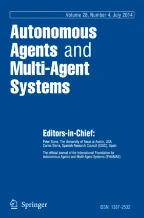Abstract
A number of frameworks for decentralized probabilistic reasoning, constraint reasoning, and decision theoretic reasoning assume a junction tree agent organization (JT-org). A natural decomposition of agent environment may not admit a JT-org. Hence, JT-org construction involves three related tasks: (1) Recognize whether a JT-org exists for a given environment decomposition. (2) When JT-orgs exist, construct one. (3) When no JT-org exists, revise the environment decomposition so that one exists and then construct it. Task 3 requires re-decomposition of the environment. However, re-decomposition incurs loss of JT-org linked privacy, including agent privacy, topology privacy, privacy on private variables, and privacy on shared variables. We propose a novel algorithm suite Distributed Agent Environment Re-decomposition (DAER) that accomplishes all three tasks distributively. For Tasks 1 and 2, DAER incurs no loss of JT-org linked privacy. For Task 3, it incurs significantly less privacy loss than existing JT-org construction methods. Performance of DAER is formally analyzed and empirically evaluated.
Similar content being viewed by others
Explore related subjects
Discover the latest articles, news and stories from top researchers in related subjects.References
Aji, S. M., & McEliece, R. J. (2000). The generalized distributive law. IEEE Transactions Information Theory, 46(2), 325–343.
Brito, I., & Meseguer, P. (2010). Cluster tree elimination for distributed constraint optimization with quality guarantees. Fundamenta Informaticae, 102(3–4), 263–286.
Gao, Y., Toni, F., Wang, H., & Xu, F. (2016). Argumentation-based multi-agent decision making with privacy preserved. In J. Thangarajah, K. Tuyls, C. Jonker, & S. Marsella, (Eds.), Proceedings 15th International Conference on Autonomous Agents and Multiagent Systems (pp. 1153–1161).
Golumbic, M. C. (1980). Algorithmic graph theory and perfect graphs. Cambridge: Academic Press.
Hoang, K. D., Fioretto, F., Hou, P., Yokoo, M., Yeoh, W., & Zivan, R. (2016). Proactive dynamic distributed constraint optimization. In J. Thangarajah, K. Tuyls, C. Jonker, & S. Marsella, (Eds.), Proceedings of 15th international conference on autonomous agents and multiagent systems (pp. 597–605).
Koller, D., & Milch, B. (2001). Multi-agent influence diagrams for representing and solving games. In Proceedings of 17th international joint conference on artificial intelligence (pp. 1027–1034).
Le, T., Fioretto, F., Yeoh, W., Son, T. C., & Pontelli, E. (2016). Er-dcops: A framework for distributed constraint optimization with uncertainty in constraint utilities. In J. Thangarajah, K. Tuyls, C. Jonker, & S. Marsella, (Eds.), Proceedings of 15th international conference on autonomous agents and multiagent systems (pp. 606–614).
Leaute, T., & Faltings, B. (2013). Protecting privacy through fistributed vomputation in multi-agent decision making. Journal of Artificial Intelligence Research, 47, 649–695.
Maestre, A., & Bessiere, C. (2004). Improving asynchronous backtracking for dealing with complex local problems. In Proceedings of 16th European conference on artificial intelligence (pp. 206–210).
Maheswaran, R. T., Pearce, J. P., Bowring, E., Varakantham, P., & Tambe, M. (2006). Privacy loss in distributed constraint reasoning: A quantitative framework for analysis and its applications. Journal of Autonomous Agents and Multi-Agent Systems, 13(1), 27–60.
Mahmoud, S., Miles, S., & Luck, M. (2016). Cooperation emergence under resource-constrained peer punishment. In J. Thangarajah, K. Tuyls, C. Jonker, and S. Marsella, (Eds.), Proceedings of 15th international conference on autonomous agents and multiagent systems (pp. 900–908).
Modi, P. J., Shen, W., Tambe, M., & Yokoo, M. (2005). Adopt: Asynchronous distributed constraint optimization with quality guarantees. Artificial Intelligences, 161(1–2), 149–180.
Petcu, A., & Faltings, B. (2005). A scalable method for multiagent constraint optimization. In Proceedings of 19th international joint conference on artificial intelligence (pp. 266–271).
Tassa, T., Grinshpoun, T., & Zivan, R. (2017). Privacy preserving implementation of the Max-Sum algorithm and its variants. Journal of Artificial Intelligence Research, 59, 311–349.
Valtorta, M., Kim, Y. G., & Vomlel, J. (2002). Soft evidential update for probabilistic multiagent systems. International Journal of Approximate Reasoning, 29(1), 71–106.
Vinyals, M., Rodriguez-Aguilar, J. A., & Cerquides, J. (2010). Constructing a unifying theory of dynamic programming DCOP algorithms via the generalized distributive law. Journal of Autonomous Agents and Multi-Agent Systems, 22(3), 439–464.
Xiang, Y. (1996). A probabilistic framework for cooperative multi-agent distributed interpretation and optimization of communication. Artificial Intelligence, 87(1–2), 295–342.
Xiang, Y. (2002). Probabilistic reasoning in multiagent systems: A graphical models approach. Cambridge: Cambridge University Press.
Xiang, Y. (2008). Building intelligent sensor networks with multiagent graphical models. In N. Ichalkaranje, G. P. Wren, & L. C. Jain (Eds.), Intelligent decision making: An AI-based approach (pp. 289–320). Berlin: Springer.
Xiang, Y., & Hanshar, F. (2015). Multiagent decision making in collaborative decision networks by utility cluster based partial evaluation. International Journal of Uncertainty, Fuzziness and Knowledge-Based Systems, 23(2), 149–191.
Xiang, Y., & Srinivasan, K. (2016). Privacy preserving existence recognition and construction of hypertree agent organization. Journal of Autonomous Agents and Multi-Agent Systems, 30(2), 220–258.
Yokoo, M., Suzuki, K., & Hirayama, K. (2005). Secure distributed constraint satisfaction: Reaching agreement without revealing private information. Artificial Intelligence, 161, 229–246.
Acknowledgements
Financial supports from the NSERC (Grant No. RGPIN-2017-03715) Discovery Grant to the first author, and the Scholarship from the Saudi Arabian Cultural Bureau to the second author are acknowledged.
Author information
Authors and Affiliations
Corresponding author
Additional information
Publisher's Note
Springer Nature remains neutral with regard to jurisdictional claims in published maps and institutional affiliations.
Rights and permissions
About this article
Cite this article
Xiang, Y., Alshememry, A. Privacy sensitive environment re-decomposition for junction tree agent organization construction. Auton Agent Multi-Agent Syst 34, 15 (2020). https://doi.org/10.1007/s10458-019-09438-6
Published:
DOI: https://doi.org/10.1007/s10458-019-09438-6
